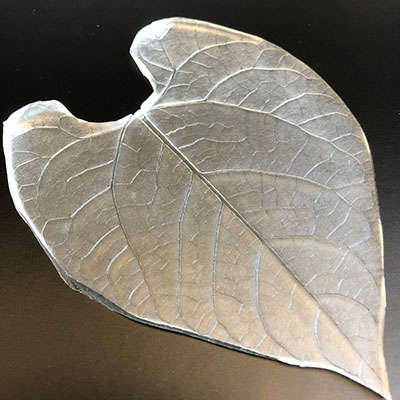How might the roughness of a leaf surface help or hinder microorganisms as they strive to attach to and survive in the leaf surface environment (also known as the phyllosphere)? This is a question that Johan Leveau and his lab members and collaborators explored in a recent article published in Phytobiomes Journal.
“By roughness we not only mean the kind that you can see with the naked eye (for example, the bottom side of a leaf may often look less even and more veiny than the top of the same leaf), but also the tiny bumps, gaps, and ridges on the leaf surface that can only be seen with a microscope,” said Leveau. “To answer this question, we used a technique familiar to anyone who’s ever had a dental cast made, a process that involves a reproduction of one’s teeth obtained from a negative dental impression in wax.”
Of course, instead of teeth, Leveau and his team used a plant leaf and, in place of wax, a polymer known as

PDMS, which resulted in a leaf replicast. This replicast represents an accurate replica of the miniature world that microorganisms such as bacteria and fungi encounter on a plant leaf; these replicas are also known as topomimetics, because they mimic the topography of the leaf surface.
“We compared the PDMS replicasts of both rough and smooth leaf surfaces and found that topography played a huge role in how far and in what directions water moved along the surface,” Leveau explained. “Veins in particular supported the formation of a network of connected water drops on the topomimetic surface, which in turn allowed the movement of bacteria and chemicals over considerable distances. The presence of veins also clearly favored the survival of bacteria on a drying surface.”
This study offered new insights into the interplay between leaf surface topography and waterscape (also known as the ‘phyllotelma’) and how this interplay impacts bacteria and other microorganisms in the phyllosphere. It is also one of the first articles to take a seriously quantitative look at the role of leaf surface topography in relation to the size and shape of the leaf surface waterscape.
“One of the most surprising aspects about these PDMS leaf replicasts is how much microscopic detail is preserved during the casting process if they are made properly. Even leaf surface experts had a hard time telling the real leaves from the PDMS replicasts under a microscope,” said Leveau. “We were also surprised to find patterns of bacterial clumping near veins and leaf hairs on topomimetic surfaces which were very similar to those found on real leaves. On real leaves, such clumping behavior is typically explained by assuming that there are spots where the leaf is leaking nutrients that the bacteria use to reproduce. Our data suggest that such clumping may simply be an outcome of the physical interactions between the leaf surface topography and waterscape.”
The PDMS leaf replicast study also revealed that proximity is not a good predictor of microbial interactions. For example, two bacteria separated by only a few body lengths might not be aware of each other’s presence due to a topographical barrier, such as a vein between them, whereas two bacteria along the same side of the same vein would be able to communicate or compete over great distances through a film of water clinging to that vein.
